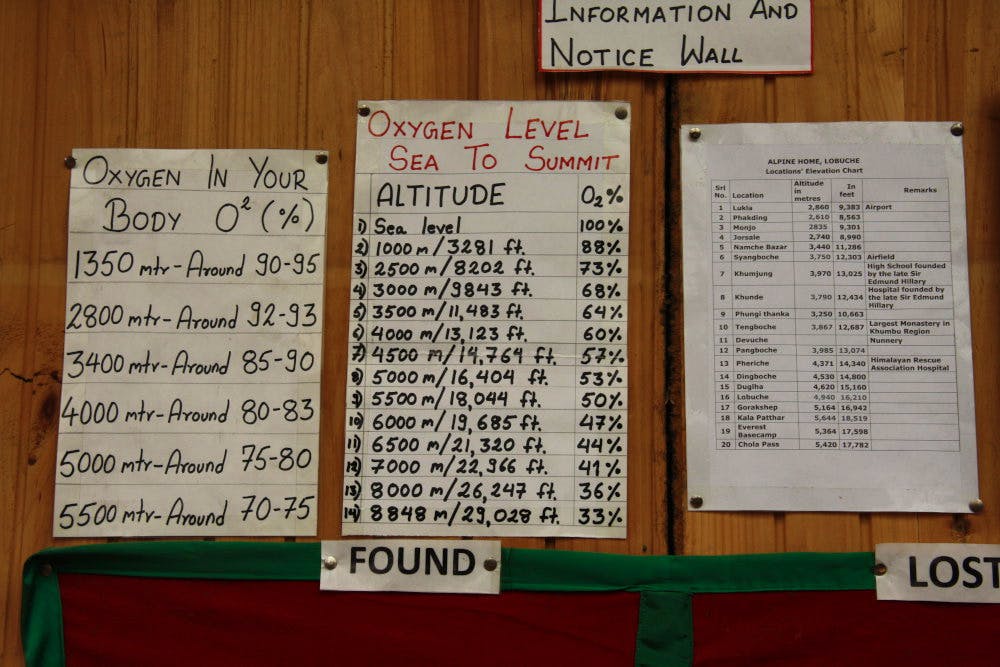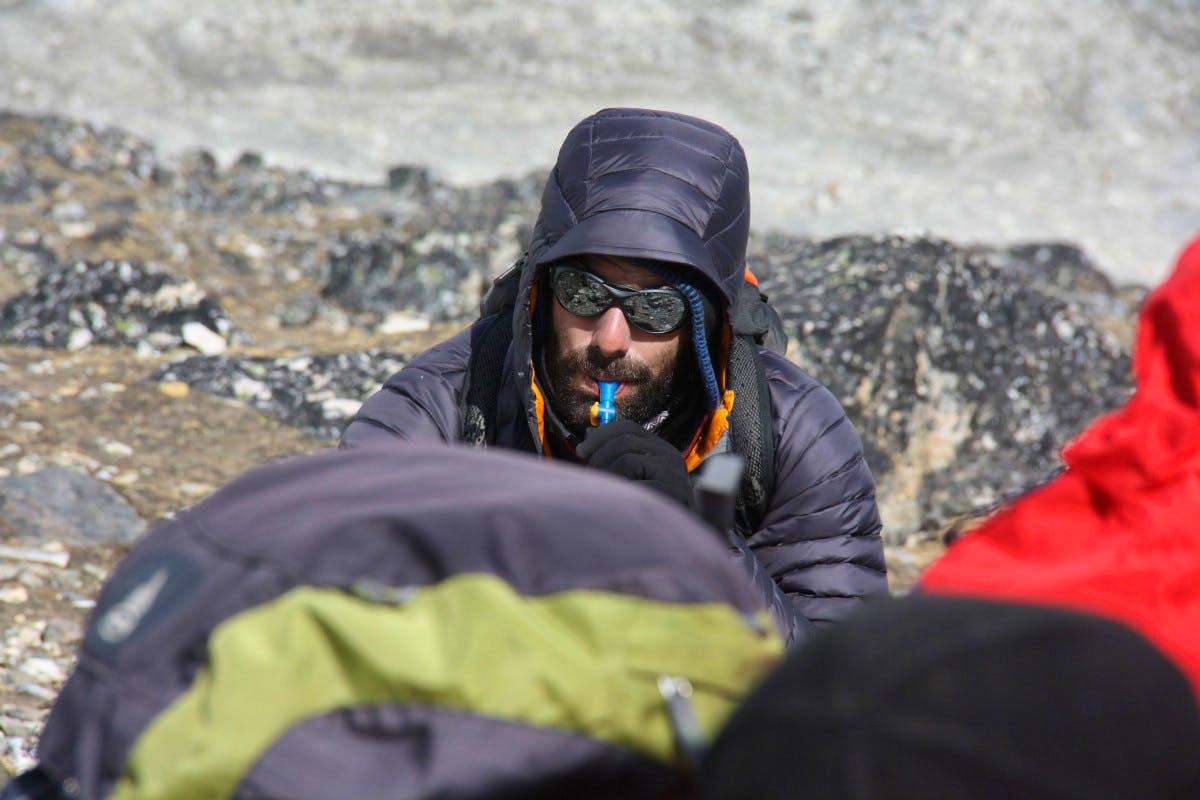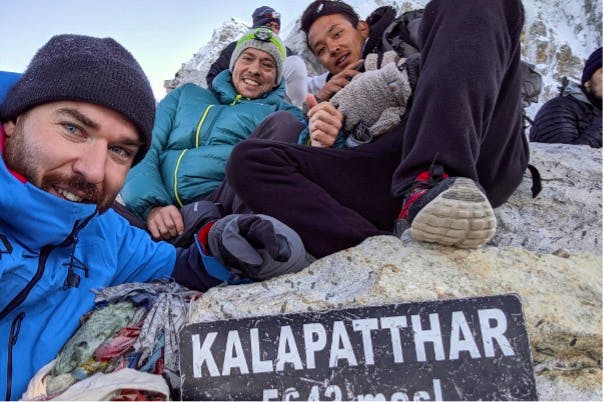Oxygen Level at Everest Base Camp: Navigating the Thin Air
Understanding the oxygen level at Everest Base Camp is crucial for any adventurer setting their sights on this iconic trek.
The allure of standing at the base of the world's highest mountain is undeniable, but it comes with its own set of challenges. Let's delve into the science, risks, and essential preparations needed to experience this high-altitude adventure safely.
The Science of Oxygen Levels at Everest Base Camp and Other High Altitudes
At Everest Base Camp, which sits at an altitude of approximately 17,600 feet, the oxygen levels are about 50% less oxygen compared to sea level.
See the chart on oxygen levels from sea to summit below.

What Causes the Lower Oxygen Levels at Everest Base Camp?
When you ascend to higher altitudes, the atmospheric pressure decreases, which, in turn, reduces the amount of oxygen available for your body to absorb.
Simply put, the higher you go, the less oxygen there is in the air. This phenomenon is not just unique to Everest Base Camp; it's a universal truth for all high-altitude locations.
How Does the Lower Oxygen Level at Everest Base Camp Affect Travellers?
Arterial blood gases are crucial in how your body adapts to high-altitude conditions. These gases, specifically oxygen and carbon dioxide, are indicators of your respiratory function and how hard it works.
Your body has to work harder to distribute oxygen to your tissues and organs in higher altitudes, which can lead to fatigue and other symptoms if not appropriately managed.
Understanding the science behind oxygen levels at high altitudes is not just academic; it's a practical necessity for anyone considering the Everest Base Camp trek.
Being aware of these factors can help you prepare better and make informed decisions, ensuring a safer and more enjoyable adventure.
Did You Know? The term for altitude sickness in Nepali is "Biralo Bhaneko," which literally translates to "acting like a cat" because of the sluggish, lethargic behavior it induces.


Latest Deals
The Reality of Altitude Sickness
Altitude sickness is a common concern for trekkers heading to Everest Base Camp, and it's something you should take seriously.
The symptoms of altitude sickness can range from mild to severe and typically include headaches, nausea, dizziness, and shortness of breath. In more extreme cases, you may experience vomiting, insomnia, and fatigue.
These symptoms usually manifest at altitudes above 8,000 feet, and they can worsen if you ascend too quickly without giving your body time to acclimate.
According to U.S. News & World Report, most travellers complained of experiencing some form of altitude sickness while at Everest Base Camp, which sits at 17,600 feet.
This isn't surprising, given the significant drop in oxygen levels at such high altitudes.
It's crucial to listen to your body and take preventive measures like ascending slowly, staying hydrated, and considering medications like acetazolamide, commonly known as Diamox, which can help prevent the onset of symptoms.

Physical Dangers and Health Risks
When it comes to high-altitude trekking, knowledge is your best defence against the physical dangers and health risks you'll encounter.
Acute Mountain Sickness (AMS) is the most common form of altitude sickness. It is often the first sign that your body struggles to adapt to the reduced oxygen levels at Everest Base Camp.
Symptoms include headaches, nausea, and fatigue. If you experience these symptoms, you must halt your ascent and allow time for acclimatisation.
The risks of ignoring altitude sickness can be severe, leading to life-threatening conditions like high-altitude pulmonary oedema (HAPE) or high-altitude cerebral oedema (HACE), both of which require immediate descent and medical attention.
HAPE is a life-threatening condition where fluid accumulates in the lungs, making breathing difficult.
On the other hand, HACE is fluid buildup in the brain, leading to disorientation and, if untreated, coma or death. Both conditions require immediate descent and medical intervention.
Proper gear and preparation can mitigate these risks and turn your trek into the best trek possible.
Your gear should include essentials like high-quality boots, thermal clothing, and, most importantly, a reliable oxygen supply for higher altitudes. So, think carefully about the items you add to your Everest Base Camp packing list.
Preparation also involves physical training to improve your cardiovascular fitness and stamina and mental preparation to handle the psychological stresses of high-altitude trekking. Start training for Everest Base Camp at least three months before your adventure.
Remember, reaching Everest Base Camp is an incredible achievement, but it's not worth risking your life.
Proper gear and preparation are not just optional but necessities for a safe and successful trek. Being well-prepared can make the difference between a life-changing experience and a life-threatening situation.
Conclusion
Understanding the oxygen levels and recognising the symptoms of altitude sickness are crucial for a safe and fulfilling adventure. With the proper preparation and awareness, your journey to Everest Base Camp can be a life-changing experience.
More EBC Articles
Popular EBC Trips
Find your next adventure
Why Skyhook?
Join over 27,000 Skyhook adventurers who've used our platform to book directly with our vetted local guides, at local prices (we never markup).
Expert Local Guides
Experienced local guides, handpicked by us.
Best Prices
Never pay a markup on the local guide's price.
Exclusive Club
Earn loyalty rewards every time you travel.
Great Social Vibes
Small group tours provide a richer experience.
Stellar Feedback
Over 2,800 reviews, average of 4.9/5 stars.












